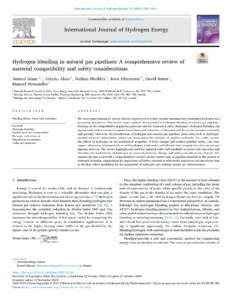Hydrogen Blending in Pipelines Report
 Blending hydrogen into natural gas pipelines is emerging as a practical strategy to reduce CO₂ emissions, but as recent research reveals, it’s far from a plug-and-play solution. Hydrogen embrittlement remains a central issue, as hydrogen’s small atoms can penetrate pipeline materials, degrading their integrity. Both vintage and modern pipeline steels are affected, though to varying extents. Older “vintage” steels, rich in carbon, are more susceptible to hydrogen-assisted cracking, while modern steels fare better due to advanced alloying techniques. Degradation effects extend to non-metal materials, impacting components like plastics, elastomers, and even odourants used in pipelines can make hydrogen degradation worse.
Blending hydrogen into natural gas pipelines is emerging as a practical strategy to reduce CO₂ emissions, but as recent research reveals, it’s far from a plug-and-play solution. Hydrogen embrittlement remains a central issue, as hydrogen’s small atoms can penetrate pipeline materials, degrading their integrity. Both vintage and modern pipeline steels are affected, though to varying extents. Older “vintage” steels, rich in carbon, are more susceptible to hydrogen-assisted cracking, while modern steels fare better due to advanced alloying techniques. Degradation effects extend to non-metal materials, impacting components like plastics, elastomers, and even odourants used in pipelines can make hydrogen degradation worse.
The solution to these technical challenges doesn’t solely rest on stronger materials but increasingly on protective coatings, which is where Triton Hydrogen’s Tritonex Hydrogen Barrier Coating system comes into play. As the only coating certified under ISO 17081 to achieve 100% hydrogen permeation isolation, Tritonex acts as a formidable barrier, preventing hydrogen atoms from seeping into pipeline surfaces. This is a significant step forward as Tritonex mitigates embrittlement and leakage, addressing the dual threat of structural degradation and environmental impact.
Why Tritonex is Key to Hydrogen Blending Success
Tritonex leverages cutting-edge nanotechnology to create a durable, water-based coating that is both chemically inert and non-toxic, ideal for varied pipeline substrates. Its application versatility—whether by spray, brush, or robot-assisted methods—makes Tritonex a feasible option for both new pipelines and retrofitting existing infrastructure. Once applied, Tritonex forms a hermetic seal that isolates hydrogen from the underlying materials, reducing both the risk of hydrogen embrittlement and the potential for leakage. This capability is particularly crucial as hydrogen blending projects expand globally, given that leakage not only threatens structural safety but also intensifies hydrogen’s indirect warming impact by extending the lifetime of greenhouse gases like methane.
Tritonex’s Role in Creating a Sustainable Hydrogen Pipeline Network
Beyond technical performance, Tritonex supports the hydrogen economy’s sustainability goals. By effectively sealing pipelines, it reduces the need for costly material replacements, optimising infrastructure lifespan while cutting down on associated environmental impacts. Test results from independent labs demonstrate Tritonex’s efficacy, showing a game-changing reduction in hydrogen mass flow through coated steel, underscoring the coating’s potential to be a key asset in pipeline durability.
Moving Forward: Integrating Tritonex in Pipeline Standards
As the hydrogen sector evolves, updated standards will be critical to safely scale hydrogen blending projects. Triton Hydrogen is actively collaborating with industry stakeholders including leading European universities and global companies interested in hydrogen solutions. This momentum, combined with Tritonex’s proven protective capabilities, positions Triton Hydrogen to drive standardisation in hydrogen pipeline coatings and contribute to the establishment of robust, hydrogen-compatible infrastructure.
In summary, Tritonex addresses the pressing need for durable, hydrogen-resistant coatings in natural gas pipelines, promising not only to preserve infrastructure but also to support the broader goals of sustainable energy transition. This innovative solution, by protecting against both hydrogen embrittlement and leakage, helps bridge the technical and safety gaps inherent in blending hydrogen with natural gas, making Tritonex a pivotal element in realising a hydrogen-inclusive energy future.
[Pipeline photograph by Tim Reckmann Creative Commons Licence.]

